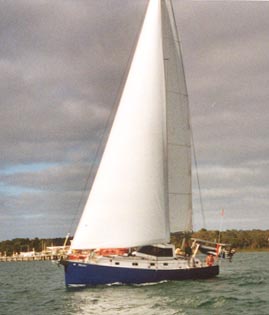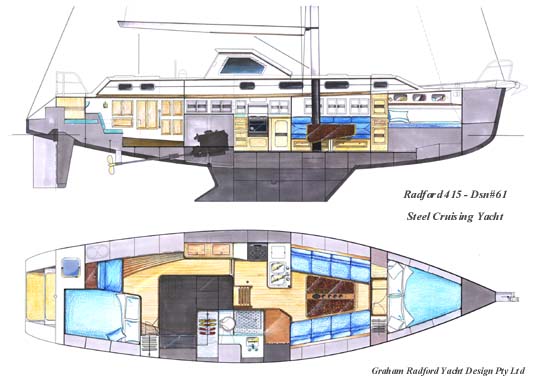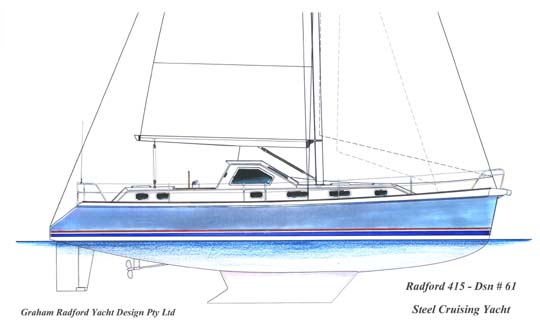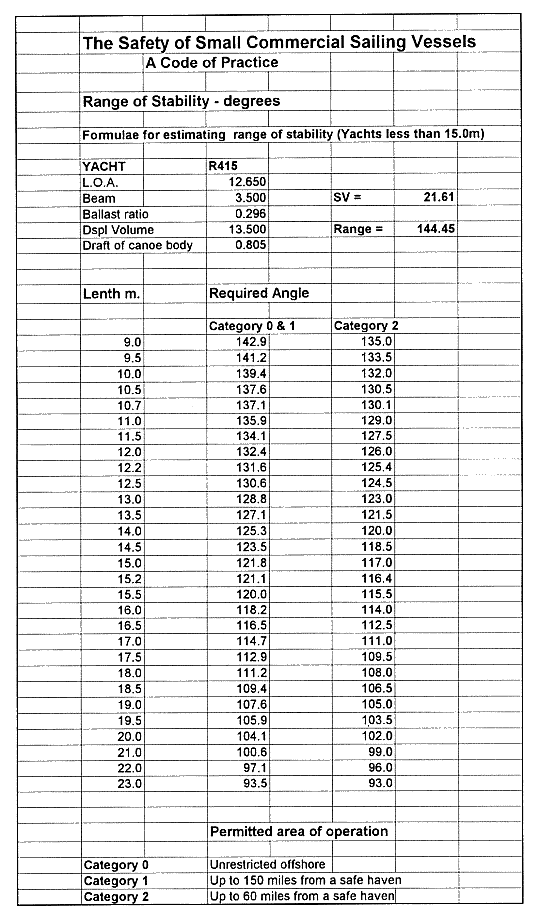


| L.O.A. | 12.65m | 41'6" |
| L.W.L. | 12.125m | 39'9" |
| Beam | 3.5m | 11'6" |
| Draft | 1.75m | 5'9" |
| Dspl | 13,290kg | 29,300lb |
| SAIL AREA | ||
| Main | 40.42sq m | 435sq ft |
| Genoa | 54.14sq m | 582.8sq ft |
| Yankee | 31.88sq m | 343sq ft |
| Staysail | 13.86sq m | 149.2sq ft |
| Storm Jib | 9.95sq m | 107.1sq ft |
The R415 is the latest of the R1000 Series steel cruising yachts and replaces the R400 which was designed in 1987. The increase in overall length of the R415 is accounted for by the size of the boarding platform and transom angle.
The R415 can be assembled from a plasma cut kit. The kit saves a lot of time in the construction of the hull and deck, with no need to loft any of the components and very little bending (stringers) or cutting required. Plating of a round bilge hull is illustrated at Plating Sequence for a Metal Hull.
The Steel Kit Construction section describes the characteristics of the R1000 Series hulls, general design considerations, plus assembly and contents of the kits.
The R415 is currently available with a centre cockpit layout.
The accommodation drawings give an indication of what will easily fit into the space available. As the accommodation does not contribute to the structural strength of the yacht it can be easily altered to suit the owner's requirements. Tanks are mostly located below the cabin sole. All layout drawings show comfortable, wide settees with angled backrests. The galleys are large with plenty of stowage. The forward vee berths can be converted to a double or, built as single upper and lower berths.
Use the navigation aids at the top of the page to view the various accommodation layouts for the centre cockpit version of the R415.
The keel stepped double spreader rig - with swept back spreaders - can be used as either a sloop or cutter. The cutter would be favoured for cruising with the staysail becoming the storm jib when required.
| Waterline | Displacement | Loading | ||
|---|---|---|---|---|
| 50mm (2") Up | 11,990kg | 26,433lb | nil | nil |
| 25mm (1") Up | 12,640kg | 27,866lb | 650kg | 1433lb |
| @ D.W.L. | 13,290kg | 29,300lb | 1,300kg | 2,866lb |
| 25mm (1") Down | 13,960kg | 30,776lb | 1,970kg | 4,343lb |
| 50mm (2") Down | 14,650kg | 32,298lb | 2,660kg | 5,864lb |
| 75mm (3") Down | 15,340kg | 33,819lb | 3,350kg | 7,385lb |
The R415 has good volume and the carrying capacity required for a cruising yacht. The following information shows the range of loading and changes in waterlines.
An effort should be made to build and load the yacht within the figures recommended. Overbuilding or adding any unnecessary weight during construction and fitout will detract from optimum loadings.

| Water | litres | UK gal | US gal |
|---|---|---|---|
| 4 x 68l | 272l | 60gal | 71.8gal |
| 1 x 165l | 165l | 36.2gal | 43.6gal |
| Total | 437l | 96.2gal | 115.4gal |
| Fuel | litres | UK gal | US gal |
| 2 x 66l | 132l | 29gal | 34.9gal |
| 1 x 189l | 189l | 41.6gal | 49.9gal |
| Total | 321l | 70.6gal | 84.8gal |

All the lead ballast is in the bulb section of the foil giving a low centre of gravity.
The R415 has a fabricated "bulb" keel with 1.75m (5'9") draft. The lead ballast is contained in the lower "bulb" section of the foil to give the lowest centre of gravity possible ... it is, in fact, only 185mm (7 1/4") from the keel base! This draft is necessary to achieve a reasonable range of positive stability for unrestricted offshore sailing - as discussed next.
An aim of this design is to give a relatively high range of stability for a steel cruising yacht.
Under the Code of Practice from the Department of Transport in the U.K. - "Safety of Small Commercial Sailing Vessels" - a yacht of 12.65m L.O.A. (41'6") needs to achieve a range of positive stability of 131deg for unrestricted offshore use (Category O).
Using the Code of Practice formula for estimating the range of positive stability - based on various parameters of the hull (i.e. beam, displacement, volume, canoe body draft, ballast ratio etc.) - the R415 has an estimated range of stability of 144deg. This is probably a bit optimistic for a steel yacht, but the centre cockpit R415, built and loaded in an acceptable fashion, would meet the requirements for unrestricted offshore use.
The correct figure for any individual yacht can only be established by doing an inclination experiment, with the yacht in measured load and trim.
The table below shows estimates for the R415 plus the range of stability required by the Code of Practice for yachts between 9m and 23m L.O.A.

|
The hull structure is based on the requirements of the American Bureau of Shipping (A.B.S.) Guide for Offshore Racing Yachts.
Hull frames and floors are spaced at 600mm (24") forward of midships and 650mm (26") aft. Regularly spaced stringers (300mm - 12") allow for the use of 4mm bottom hull plate and 3mm topside plate. The frames, backbone and keel base are cut from 8mm plate; the floors, keel plate, skeg, deck and house beams etc are cut from 4mm plate; while the deck, house and cockpit are cut from 3mm plate.
| S/L Ratio | Speed - knots | SHP |
|---|---|---|
| 1.00 | 6.30 | 25.42 |
| 1.10 | 6.94 | 33.84 |
| 1.20 | 7.57 | 43.93 |
| 1.30 | 8.20 | 55.85 |
| 1.34 (maximum) | 8.45 | 61.17 |
The maximum hull speed of the R415, at Speed / Length Ratio (S/L) = 1.34, is 8.45 knots. An efficient cruising speed is at S/L = 1.1, or 6.94 knots. The list shows the required shaft horsepower (SHP) for different speeds at 14,000kg (30,840lb) displacement. Note the rapid increase in required SHP (hence fuel consumption) for small gains in speed.
Based on a speed requirement, select an engine which - running at an optimum RPM - will give the required SHP for that speed.
The combination of the rig and hull shape will ensure good sailing performance while the airy accommodation space and the strength of the steel hull gives a safe, comfortable offshore cruising yacht.